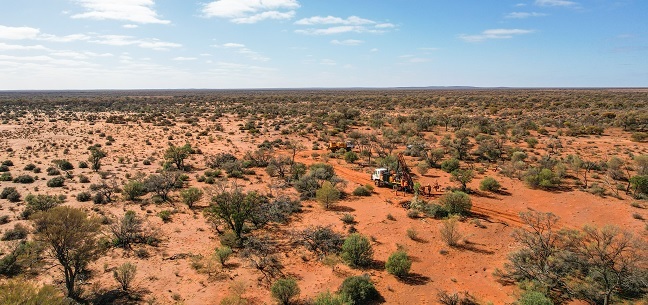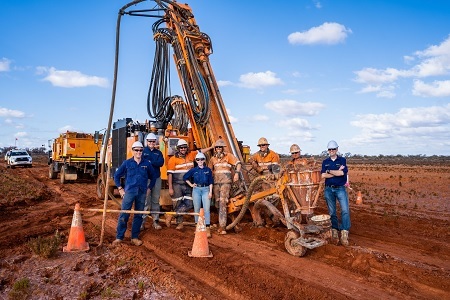The former Newmont geologist is an unabashed gold bug, excited about the "wild card" potential of Saturn's joint venture at the past-producing high grade West Wyalong project in New South Wales, plus the company's very promising landholding at Apollo Hill in WA's prolific Goldfields.
Within three years of listing, Saturn has virtually doubled Apollo Hill's resource at the solid conversion rate of 5.4oz per metre drilled.
The deposit 60km south-east of Leonora has also yielded excellent metallurgical results, which point to a big, simple, low-cost openpit mine, while drilling results this year have opened up further potential.
Bamborough said the company had a good team of gold explorers, who believed Apollo Hill had the potential to be a stable performer in a region where it's surrounded by plenty of other gold deposits and operations.
"Beyond that, we've got I think some of the best greenfields gold exploration ground in left in this country," he said.
He described the 1,000sq.km strategic landholding as the last bastion of untouched ground in the eastern Goldfields.
"This year, we've been out and probably done about 25,000 metres of air core so far and it's the first time we've really been able to step into this virgin territory, and it's starting to yield results," he said.
Since January's resource update, Saturn has reported some of the best intersections to date at Apollo Hill, including 8m at 8.83g/t from 6m, extended the mineralisation substantially to the south and demonstrated the potential for low-cost gold recovery through extensive metallurgical testing.

Drilling at Saturn Metals' flagship Apollo Hill gold project in WA
"We have three initiatives - one is looking for grade leverage points underneath the existing resource pit shell," Bamborough said.
"We've had some of the best intersections we've ever seen in the history of the deposit … and of course that helps drive the economics."
The next phase of drilling added about 1km of mineralisation to the south of the orebody on the Ra-Tefnut corridor.
Results mid-year included 18m at 2.72g/t gold from 89m, including 9m at 4.71g/t.
"So you've gone from 1.4km to 2.4km, in a nutshell, and again with some really nice intersections in grade and I think it will bode well for the next resource upgrade," Bamborough said.
The company has now turned its attention to the north and Bamborough described the results released weeks ago as fantastic.
Extensional drilling returned 7m at 11.18g/t from 172m, including 25.67g/t.
At the same time, resource upgrade drilling returned 54m at 1.34g/t from 16m, including 9m at 2.84g/t from 25m and 10m at 3.29g/t from 45m.
"It's really opened up that northern corridor as well, so the drill rig will be back there very, very soon," Bamborough said.
"We're also delighted with the sort of high grades and a very different looking style of mineralisation, so that's got the company quite excited."
Met testing offers step change
Saturn recently undertook an extensive metallurgical testing programme at Apollo Hill, to accentuate the existing results which had been focused on a limited area.
The key findings point to a step change in the deposit and its size potential: results indicated the possibility of low-cost gold recoveries in what was previously considered waste material.
Firstly, Bamborough said the testing revealed excellent overall gold recovery of 96.8% from samples across Apollo Hill's major material types and grade range, at normal commercial grind sizes.
"Most importantly, out of that, we found that 65% of that recovery was done with gravity gold," he said.
"So that's cheap, simple physical processing, no reagents, and that really can help with one of the major cost structures in reducing the unit costs of the deposit.
"For deposit like Apollo Hill with that big tonnage and that lower grade scenario, it can really help drive the margin, so that to me was a very important step to accentuate.

Exploration is in full swing at Saturn Metals' Apollo Hill in WA
"We then looked at how the material performed at coarser grind sizes, being around 250 microns, which essentially means less energy use, less time grinding, quicker recoveries, that kind of thing.
"We were delighted to still see across all those material types and the whole deposit, at 91.3% to be exact but again, very importantly, the gravity was up in the sort of 56% region.
"Beyond that, we took it another step further and looked at that material if we crushed it - just crushed it not ground it necessarily - to 2mm, we were again seeing very high recoveries."
This was an average 80.3% gold recovery, with very strong gravity recovery of 47.8%, which Bamborough said would lead into the next phase of test work towards heap leaching, that could offer low prices and further capital cost efficiencies.
"Usually in a deposit, the lower grade you get, the less recovery you get, we're just not seeing that at Apollo Hill with the deposit having a very flat and positive grade recovery curve," he said.
"It gives us the potential to treat much lower grade dirt … and what was essentially waste then has the potential to become ore.
"So putting everything together, we've had a great drill programme in the first six months, we've then extended it to the north we're then bringing the metallurgy together and all those factors will be used in that next resource upgrade," he said.
"Two plus two plus two equals eight, not six, is what we're looking for and really, I think we have the potential to get it."
Wild card
Over in New South Wales, Saturn has conducted initial drilling at what Bamborough describes as "a bit of a wild card" - its West Wyalong high grade vein opportunity on the Lachlan Fold belt.
"It's probably one of the highest-grade historic goldfields in in Australia and long forgotten," Bamborough said.
West Wyalong is said to have produced 439,000oz at 36g/t.
Saturn has made the Mallee Bull reef its initial focus.
Mallee Bull was mined at grades of up to 55g/t and face samples of up to 155g/t have been recorded, with mining winding up in 1915 when a decline in production coincided with World War I.
"I don't think anyone is drilled there in about 100 years on the particular structure we've targeted so it's been very much a first go," Bamborough said.

Saturn Metals MD Ian Bamborough
He described early drilling results as "close but no cigar" with gold mineralisation discovered, the right mineral alteration and right geology but no stellar grades - yet.
"I think we could be close to something very important," he said.
"I'm in no way discouraged, it's still very early days.
"Given its history, I think it's a matter of time before we unlock that potential."
Saturn has already earnt 20% of the joint venture, struck in 2020, and can earn up to 85% in four stages.
The tightly-held company started the quarter with A$5.8 million in cash, putting it in a healthy financial position to continue assessing Apollo Hill's full potential and better understand West Wyalong.
"Importantly, a nice position to give us a healthy kickstart to 2022's field season and results right through the Christmas period," Bamborough said.
ABOUT THIS COMPANY
Saturn Metals
HEAD OFFICE:
- 9 Havelock Street, West Perth WA 6005
- Phone: +61(0)8 6234 1114
- Email: info@saturnmetals.com.au
- Web: www.saturnmetals.com.au
SOCIAL MEDIA:
DIRECTORS:
- Ian Bamborough
- Brett Lambert
- Andrew Venn
- Rob Tyson
- Adrian Goldstone
QUOTED SHARES ON ISSUE:
- 161 million
MARKET CAP:
- A$27 million (at July 18, 2023)
MAJOR SHAREHOLDERS:
- Dundee Corporation – 19.99%
- Franklin Templeton – 9.99%
- Wythenshawe Pty Ltd and Associates – 10.17%

























